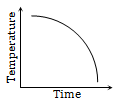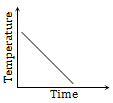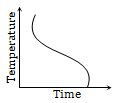Concept used NEET 2021 Physics;
Newton’s Law of Cooling;
- the rate of loss of heat from a body is directly proportional to the difference in the temperature of the body and its surroundings.
- dQ/dt ∝ (q – qs)
- dQ/dt = -k[q – qs)]
Methods to Apply Newton’s Law of Cooling
when we need only approximate values from Newton’s law, we can assume a constant rate of cooling, which is equal to the rate of cooling corresponding to the average temperature of the body during the interval.
i.e. dθ\dt = k(<q> – q0)
Derived PYQs; ⬇️
Question: From NCERT NEET Derived PYQ
A body at temperature 40ºC is kept in a surrounding of constant temperature 20ºC. It is observed that its temperature falls to 35ºC in 10 minutes. Find how much more time will it take for the body to attain a temperature of 30ºC.
a) 10 min
b)20 min
c) 8 min
d) 14 min
⬆️Prev____@organised notes_____Next⬇️
Question: From NCERT NEET Derived PYQ
The oil is heated to 70oC. It cools to 50oC after 6 minutes. Calculate the time taken by the oil to cool from 50oC to 40oC given the surrounding temperature Ts = 25oC.
a)10 min
b) 5 min
c) 15 min
d) 20 min
⬆️Prev____@organised notes_____Next⬇️
Question: From NCERT NEET Derived PYQ
Water is heated to 80oC for 10 min. How much would be the temperature if k = 0.56 per min and the surrounding temperature is 25oC?
a) 50
b) 25
c) 56
d) 35
⬆️Prev____@organised notes_____Next⬇️
Question: From NCERT NEET Derived PYQ
A body cools from C to C in minutes. Temperature of surroundings is C. Its temperature after next minutes is
⬆️Prev____@organised notes_____Next⬇️
Question: From NCERT NEET Derived PYQ
⬆️Prev____@organised notes_____Next⬇️
Question: From NCERT NEET 2014
Mapping : Physics>Thermal Properties of Matter>Newton's Law of Cooling
⬆️Prev____@organised notes_____Next⬇️
Question: From NCERT NEET Derived PYQ
Answer ▽
As we know that from emissive power and from wein's displacement law . So if emissivity will be maximum them simultaneously it's temperature will be maximum, but from the wein's law we can say that the particle which has maximum temperature will have lower wavelength. So,
So, we can say:
But,
So, we can say:
But,
⬆️Prev____@organised notes_____Next⬇️
Question: From NCERT NEET Derived PYQ
A body cools down from in 5 minutes. The temperature of the body will fall from in a time
1. Less than 5 minutes
2. equal to 5 minutes
3. More than 5 minutes
4. Can't say anything like the temperature of surrounding is not known
Answer ▽
3. More than 5 minutes
⬆️Prev____@organised notes_____Next⬇️
Question: From NCERT NEET 2016
A body cools from a temperature 3T to 2T in10 minutes. The room temperature is T. Assume that Newton's law of cooling is applicable. The temperature of the body at the end of next 10 minutes will be -
(a) (b)
(c) (d)
Mapping : Physics>Thermal Properties of Matter>Newton's Law of Cooling
Answer ▽
b)
From newton's law of cooling
Let us say temperature after 10 minutes become T1
Then
⬆️Prev____@organised notes_____Next⬇️
Question: From NCERT NEET 2019
An object kept in a large room having an air temperature of 25° C takes 12 minutes to cool from 80° C to 70° C. The time taken to cool for the same object from 70° C to 60° C would be nearly -
1. 10 min
2. 12 min
3. 20 min
4. 15 min
Mapping : Physics>Thermal Properties of Matter>Newton's Law of Cooling
⬆️Prev____@organised notes_____Next⬇️
Question: From NCERT NEET Derived PYQ
A bucket full of hot water cools from 75 to 70 in time , from 70 to 65 in time and from 65 to 60 in time , then
(1)
(2)
(4)
Answer ▽
(3)
⬆️Prev____@organised notes_____Next⬇️
Question: From NCERT NEET Derived PYQ
Consider two hot bodies and which have temperatures 100 and 80 respectively at t=0. The temperature of the surroundings is 40. The ratio of the respective rates of cooling and of these two bodies at t=0 will be
(1)
(2)
(3)
(4)
⬆️Prev____@organised notes_____Next⬇️
Question: From NCERT NEET Derived PYQ
Newton's law of cooling is a special case of
(1) Stefan's law
(2) Kirchhoff's law
(3) Wien's law
(4) Planck's law
Answer ▽
(1) Stefan's law
Newton's law cooling is a special case of Stefan-Boltzmann’s law where the temperature difference of the body and the surrounding is very small.
Let us understand what the other laws given in the options tell us.
(i) Kirchoff’s law: It says that the ratio of emissive power to absorptive power is the same for all surfaces at the same temperature and is equal to the emissive power of a perfectly black body at that temperature.
(ii) Wien’s law: According to this law, the product of wavelength for which a black body emits radiation of maximum intensity and the temperature of the body is constant.
⬆️Prev____@organised notes_____Next⬇️
Question: From NCERT NEET Derived PYQ
In Newton's experiment of cooling, the water equivalent of two similar calorimeters is 10 gm each. They are filled with 350 gm of water and 300 gm of a liquid (equal volumes) separately. The time taken by water and liquid to cool from 70°C to 60°C is 3 min and 95 sec respectively. The specific heat of the liquid will be
(1) 0.3 Cal/gm °C
(2) 0.5 Cal/gm °C
(3) 0.6 Cal/gm °C
(4) 0.8 Cal/gm °C
Answer ▽
The correct option is C
0.6 Cal/gm ´°C
Sl=1ml[tltw(MwCw+W)−W]
= 1300[953×60(350×1+10)−10]=0.6Cal/gm×∘C
⬆️Prev____@organised notes_____Next⬇️
Question: From NCERT NEET Derived PYQ
The rates of cooling of two different liquids put in exactly similar calorimeters and kept in identical surroundings are the same if
(1) The masses of the liquids are equal
(2) Equal masses of the liquids at the same temperature are taken
(3) Different volumes of the liquids at the same temperature are taken
(4) Equal volumes of the liquids at the same temperature are taken
Answer ▽
(4) Equal volumes of the liquids at the same temperature are taken
Rate of loss of heat will depend on the surface area
So, when volume is same, the surface area will also be same
⬆️Prev____@organised notes_____Next⬇️
Question: From NCERT NEET Derived PYQ
The temperature of a liquid drops from 365 K to 361 K in 2 minutes. Find the time during which temperature of the liquid drops from 344 K to 342 K . Temperature of room is 293 K
(a) 84 sec (b) 72 sec
(c) 66 sec (d) 60 sec
Answer ▽
(a) 84 sec
The correct option is A 84 sec
Newton's law of cooling says that,
θ1−θ2t∝(θ1+θ22−θ0)
From the data given in the question,
365−3612=K[365+3612−293]
⇒K=135 min−1
Again, for change in temperature from 344 K to 342 K,
344−342t=135[344+3422−293]
⇒2t=107
⇒t=75 min=75×60=84 sec
Thus, option (a) is the correct answer.
⬆️Prev____@organised notes_____Next⬇️
Question: From NCERT NEET Derived PYQ
Newton’s law of cooling, holds good only if the temperature difference between the body and the surroundings is
(1) Less than 10
(2) More than 10
(3) Less than 100
(4) More than 100
Answer ▽
(1) Less than 10
⬆️Prev____@organised notes_____Next⬇️
Question: From NCERT NEET Derived PYQ
The temperature of a body falls from 50 to 40 in 10 minutes. If the temperature of the surroundings is 20, then temperature of the body after another 10 minutes will be-
(1) 36.6
(2) 33.3
(3) 35
(4) 30
⬆️Prev____@organised notes_____Next⬇️
Question: From NCERT NEET Derived PYQ
A body takes 5 minutes to cool from 90 to 60. If the temperature of the surroundings is 20, the time taken by it to cool from 60 to 30 will be.
(1) 5 min
(2) 8 min
(3) 11 min
(4) 12 min
Answer ▽
(3) 11 min
=
And again minute
⬆️Prev____@organised notes_____Next⬇️
Question: From NCERT NEET Derived PYQ
An object is cooled from 75°C to 65°C in 2 minutes in a room at 30°C. The time taken to cool another object from 55°C to 45°C in the same room in minutes is -
(1) 4
(2) 5
(3) 6
(4) 7
Answer ▽
According to Newton's law of cooling,
−dθdt∝(θ−θ0)
−dθdt=K(θ−θ0)
where, K is a constant of proportionality.
Now, 75−652=K(75+652−30)=K×40⇒K=18
In case of second identical object
55−45t=K(55+452−30)
10t=18×20
⇒t=8020=4 min
⬆️Prev____@organised notes_____Next⬇️
Question: From NCERT NEET Derived PYQ
A cane is taken out from a refrigerator at 0°C. The atmospheric temperature is 25°C. If is the time taken to heat from 0°C to 5°C and is the time taken from 10°C to 15°C, then
(1)
(2)
(3)
(4) There is no relation
Answer ▽
2)
⬆️Prev____@organised notes_____Next⬇️
Question: From NCERT NEET Derived PYQ
A block of metal is heated to a temperature much higher than the room temperature and allowed to cool in a room free from air currents. Which of the following curves correctly represents the rate of cooling ?
(1)
(2)
(3)
(4)
Answer ▽
(2)
⬆️Prev____@organised notes_____Next⬇️
Question: From NCERT NEET Derived PYQ
A glass full of hot milk is poured on the table. It begins to cool gradually. Which of the following is correct?
(a) The rate of cooling is constant till milk attains the temperature of the surrounding.
(b) The temperature of milk falls off exponentially with time.
(c) While cooling, there is a flow of heat from milk to the surrounding as well as from surrounding to the milk but the net flow of heat is from milk to the surrounding and that is why it cools.
(d) All three phenomenon, conduction, convection and radiation are responsible for the loss of heat from milk to the surroundings.
(1) (a, b, c)
(2) (a, d)
(3) (b, c, d)
(4) (a, c, d)
Answer ▽
(3) (b, c, d)
⬆️Prev____@organised notes_____Next⬇️
Question: From NCERT NEET Derived PYQ
A pan filled with hot food cools from 94 °C to 86 °C in 2 minutes when the room temperature is at 20 °C. How long will it take to cool from 71 °C to 69 °C?
1. 50 sec
2. 52 sec
3. 42 sec
4. 48 sec
Answer ▽
3. 42 sec
⬆️Prev____@organised notes_____End⬇️
Subtopic;Newton's Law of Cooling



















